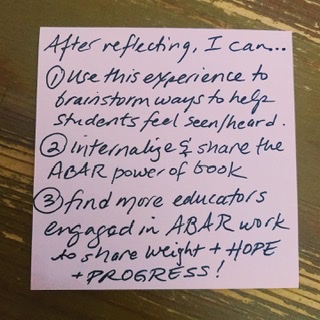My preparation for leading a guided reading during our book club yesterday looked like this:
I’m grateful to Dr. Sarah Donovan for making space for me to help with this Anti-Bias, Anti-Racism (ABAR) education work within her verse novel book club. We met last week to share thoughts on the book club, the books, and ways to address what felt like a need.
There are a lot of excellent books being recommended to teachers to add to their classroom libraries, to use as read alouds, to use with student book clubs, but is there enough guidance on how to do this mindfully and in a racially and culturally conscious way? There is a lot of mention of culturally relevant and culturally sustaining pedagogy, but is there enough (un)learning and support given to support that work?
I hope that districts and schools support their teachers with the necessary professional development to continue this work (or start it, as the case may be). But if history shows us anything, teachers will be scrambling to learn this on their own- alongside the anxiety of rolling out face-to-face, hybrid, or remote learning during a pandemic... so I found myself anxious that perhaps a well-meaning teacher might deploy one of these books and unintentionally cause harm.
As a way to address this, Sarah invited me to share a way to read a literary passage containing bias and/or racism with students by modeling a guided reading using an ABAR lens. (Of course, I was nervous, feeling imposter syndrome sharing my thinking, but I tried to make it clear that I’m not an expert and that I’ve been learning for years and will continue to learn and do better for years to come... that is a big part of this type of work!) Then, fellow book club participants practiced this.
My thinking about sharing literary passages containing examples of racism and/or bias is that whatever population of students we may work with, we need to...
1️⃣ be intentional about how to present these passages in ways that do not perpetuate the bias or racism, even unintentionally;
2️⃣ teach students how to name unfairness, injustice, and oppression (use words like racism, sexism, classism, prejudice, transphobia, xenophobia, homophobia) and
3️⃣ reaffirm aspects of their/others’ culture that may have been affected by the text by highlighting the healing the author may have written into their text.
We shared a set of questions to help teachers think through the passage and perhaps discuss that passage with students to unearth and address bias and/or racism.
Three fellow educators found and shared passages and their thoughts on the harm and healing portrayed. Another educator shared these words:
“What resonates through these moments is the power that individuals have to repair the harm happening in every moment. Using this lens allows/empowers us as teachers to address moments of harm thought the school day with our kiddos.”
My teacher heart loved that this was shared! My hope was/is that this naming of harm and highlighting healing would be an entry into ABAR work which is rich and complex, though difficult work, to empower students and our communities.
Repeat: I’m not an expert, I’m learning more every day. I’m looking for more educators to learn from and/or alongside me. Let me know if there’s an ABAR educator/education blog or website you recommend!


